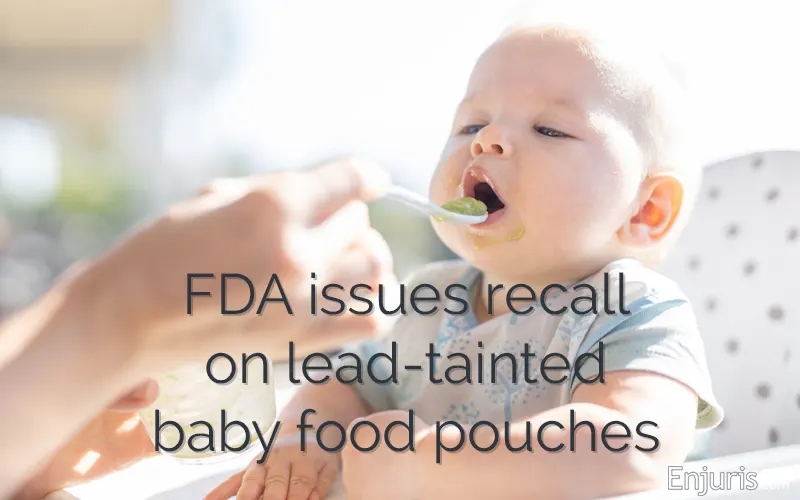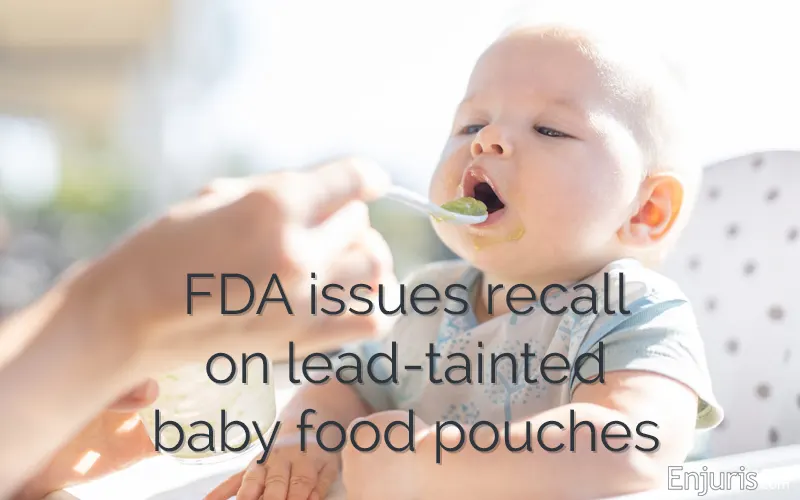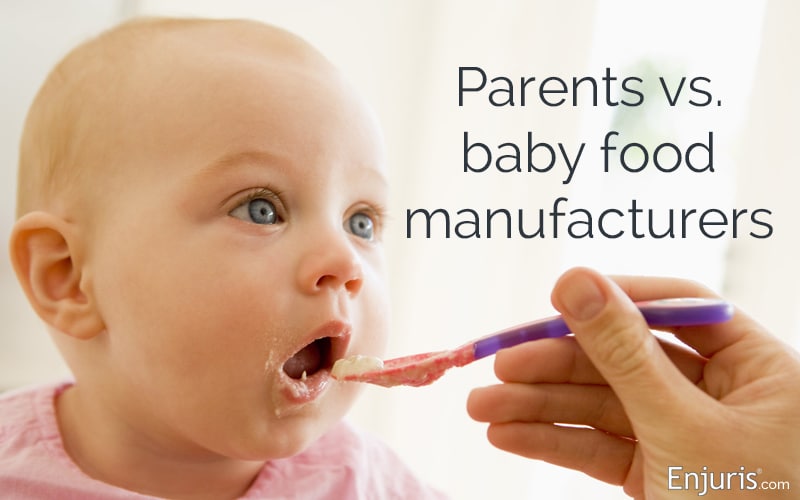[ad_1]

Baby food pouches are recalled for high lead levels
Babies are susceptible to effects of lead, even at small amounts. Here’s why it’s important, what to look for, and what to do if you believe your child is experiencing lead poisoning.
If “applesauce” conjures images of ubiquitous baby food, you’re not alone. Parents have been feeding applesauce as a first food to babies and toddlers for decades—there’s little that’s more pure or nutritious for a young one who can’t quite eat solids but is ready to branch out from a breastmilk or formula-only diet.
But if you’re the caregiver to a little one who loves applesauce pouches, beware. The FDA issued a recall on WanaBana applesauce pouches—also sold as Schnucks and Weis brands—after 52 children experienced symptoms of lead poisoning linked to the pouches.
The Food and Drug Administration (FDA) reports that the lead in the applesauce seems to be linked to the cinnamon in the sauce. The affected children live in 25 states and are up to four years old.
WanaBana is sold at DollarTree stores and by Amazon; the product is sold as Weis at Weis grocery stores and as Schnucks at Schnucks and Eatwell Markets stores.
The FDA reported finding 2.18 parts per million of lead in the pouches, which is more than 200 times the level proposed for baby food.
Lead poisoning in young children
Symptoms of lead poisoning in children
- Vomiting
- Constipation
- Learning difficulties
- Developmental delays
- Irritability
- Eating items like paint chips that are not food (pica)
- Loss of appetite
- Seizures
- Weight loss
- Hearing loss
- Abdominal pain
- Sluggishness and fatigue
The most common source of lead poisoning in children is exposure to lead-based paint or lead-contaminated dust in older buildings. Contamination could also affect air, water or soil.
Even low levels of lead exposure can lead to long-term damage. Children can be affected by risks to brain development, and there can be irreversible, life-long problems.
At higher levels of exposure, both children and adults can experience kidney or nervous system damage. High levels of lead exposure could also cause seizures, loss of consciousness or death.
The Mayo Clinic lists the following sources of lead exposure:
- Soil that contains lead particles from gasoline or paint, especially around highways and in cities
- Household dust that contains lead from paint chips or contaminated soil tracked in from outside
- Glazes found on some ceramic pottery, china or porcelain that leach into food (served or stored)
- Toys manufactured outside the U.S.
- Cosmetics manufactured outside the U.S., specifically Tiro from Nigeria and Kohl
- Greta and azarcon herbal remedies, along with other medicines from India, China and elsewhere
- Mexican candy and other food items that contain tamarind
- Lead bullets from exposure time at firing ranges (You don’t need to be shot by the bullet to be exposed.)
- Occupations like auto repair, mining, pipe fitting, battery manufacturing, painting and construction (Workers can also bring it into their homes on their clothes or shoes.)
It’s not common for lead to be found in food in the U.S., which is largely due to stringent regulations and standards. It’s also why the applesauce recall is unexpected; parents trust that the baby food they find on store shelves will be safe for their children.
As of this writing, the FDA was aware that there were still WanaBana applesauce pouches on store shelves at various DollarTree locations, but the agency is advising parents and caregivers not to purchase them.
The agency recommends the following:
- Do not eat, sell or serve recalled pouches.
- If you’ve purchased these applesauce pouches in the past, discard them.
- If you suspect your child has been exposed to lead, contact their healthcare provider to inquire about a lead blood test.
- If your child exhibits any symptoms of lead toxicity, contact their healthcare provider.
- You can file a complaint or adverse event report with the FDA.
How much lead is too much?
A 2017 report by the Environmental Defense Fund indicated that even low levels of lead in a child’s bloodstream can cause behavioral problems and lower IQ. The group found that lead was present in 20% of baby food samples, most commonly in fruit juices—and in 89% of grape juice samples. 86% of sweet potato food samples contained lead, along with certain types of arrowroot cookies and teething biscuits.
The FDA determined in 1993 that the maximum safe intake of lead per day is six micrograms, but it has not updated the guidance despite newer research about its hazards.
Is the manufacturer liable for children with lead poisoning?
At this time, there are no lawsuits for this particular recall event. There might be in the future, and Enjuris will update this article if that happens.
There have been lawsuits filed against landlords who rent apartments to parents with children who suffered effects from lead-based paint. These lawsuits claim the children’s injuries resulted from exposure to toxic paint chips and dust.
However, it would be difficult for parents to prove that lead in baby food harmed their children. One reason is that typically, the amount of lead in food is lower than the the FDA’s permitted amount.
When considering the likelihood of a parent winning a lawsuit against a food manufacturer for baby food containing lead that led to a child’s lead poisoning, several key factors come into play. The outcome of such a lawsuit heavily depends on the specifics of the case, including the evidence available, the legal framework, and the jurisdiction.
Evidence of lead contamination and causation: The parent must prove that the baby food contained lead and that this lead directly caused the child’s lead poisoning. This typically involves scientific testing and expert testimony. Without concrete evidence linking the baby food to the lead poisoning, the case could be weak.
Product liability and negligence laws: In product liability cases, manufacturers are often held responsible for any harm caused by their products. If the food manufacturer knew or should have known about the lead contamination and failed to take appropriate action, this could be grounds for a strong lawsuit.
Regulatory standards and violations: If the baby food manufacturer violated food safety standards set by regulatory agencies like the FDA, this could significantly strengthen the case. These violations can serve as evidence of negligence.
Statute of limitations: Legal time limits for filing lawsuits vary by jurisdiction. If a parent files a lawsuit after the statute of limitations has expired, the case is likely to be dismissed.
Legal representation and resources: The quality of legal representation and the resources available to pursue the case can also influence the outcome. A skilled attorney with experience in product liability cases would be crucial.
Public and media attention: Sometimes, public and media attention can influence the proceedings, especially if it leads to a broader awareness and scrutiny of the manufacturer’s practices.
Settlements vs. court trials: Many of these cases are settled out of court. Whether to settle or go to trial depends on the specifics of the case and the strategies of both parties.
Class action lawsuits: If there are multiple cases of lead poisoning from the same manufacturer, a class action lawsuit might be more effective. These cases can lead to larger settlements or judgments but can be more complex to manage.
Impact on the child: The severity of the child’s lead poisoning and its long-term effects will likely be a significant factor in determining damages.
A strong case would require solid evidence of harm caused by the manufacturer’s negligence, an understanding of the relevant legal standards, and capable legal representation. The specifics of each case are crucial in determining the outcome. At this time, the recall on the applesauce pouches is recent, and lawsuits might follow but have not yet.
Tell your story:
[ad_2]




